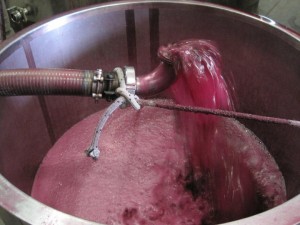Differences in Making A Red:
- Black grapes picked, destalked and crushed
- The resultant mass of juice, skin, pips, etc are put into a vat to ferment
- Fermentation begins about 20°C and allowed to rise to 32°C (warmer temps improve extraction of color and tannin)
- Temperature control needed since fermentation ceases at 35-38°C
- Often less SO2 used with red as compared to whites (higher tannins take over the antioxidant function the SO2 has)

- As the fermentation occurs, CO2 is formed and causes the must solids to rise to the top of the tank creating a “must cap”
- The cap must be mixed to keep optimal juice to skin contact and to prevent exposure to air (creating potential off odors and flavors due to microbial growth)
- Color, flavors and tannins are extracted from the skins
- When to pull off the juice and press the pomace depends upon the style of wine being made
- The longer the extraction, the more color and tannins will be in the juice
- To a large part, the tannin levels determine how long the wine will need to age before drinking
- Extended maceration: continued skin contact beyond the point that alcoholic fermentation has ended : this produces desirable changes that make the wine more palatable at an early age but will not diminish the ability of the wine to improve with bottle aging
- Fermentation takes 1-3 weeks –>maceration takes 6-12 days
- Juice pressed and placed in vats or barrels (here it will undergo malolactic fermentation and ageing)
- Malolactic fermentation in red wines is much more common than in white
- Plays a more important role in development and complexity
- Encouraged in cooler growing areas
- Discouraged in warmer regions where wines have a natural lower acidity
- During the early stages of aging, after fermentation, reds are exposed to air to help reduce off odors and to provide the necessary oxygen for normal aging

 Masters of Wine
Masters of Wine Wine and Spirits Education Trust
Wine and Spirits Education Trust